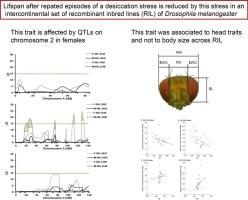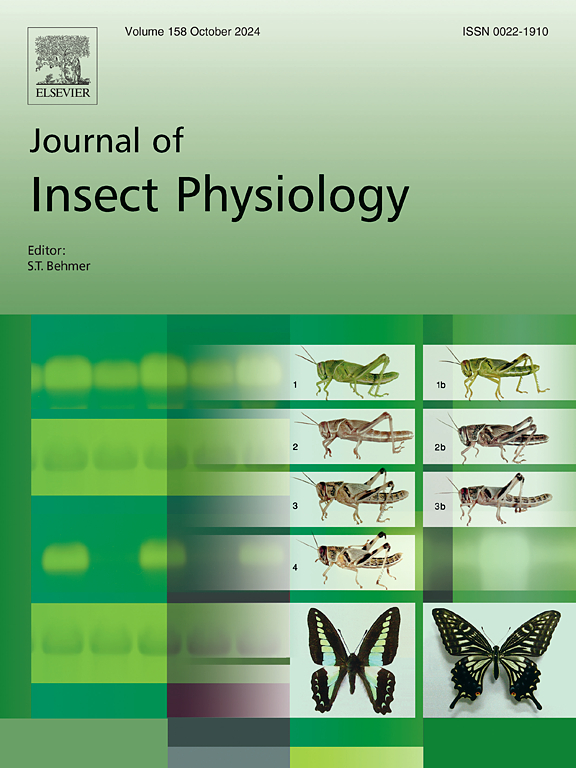干燥胁迫后的寿命在遗传上是可变的,部分与黑腹果蝇重组系的头部性状有关
IF 2.3
2区 农林科学
Q1 ENTOMOLOGY
引用次数: 0
摘要
干旱胁迫是气候变化和全球变暖背景下陆地环境中最重要的胁迫形式之一。为了寻找果蝇干燥后寿命与头部两种形态特征之间的遗传变异和可能的关联,我们使用了两组黑腹果蝇重组自交系(RIL)。通过在2、4和6日龄时将果蝇暴露在干燥环境中1.5小时,以25°C下的寿命来测量干燥存活率。与对照蝇相比,这种干燥处理显著减少了处理蝇的寿命(平均减少2.5倍)。在两个RIL组中,各系的干燥存活率差异很大,RIL的平均存活率在5至27天之间。复合区间定位发现5个qtl,均位于2号染色体上。研究发现,干旱发作后存活的遗传基础与之前在这些RIL中研究的永久干旱下存活的遗传基础部分不同。干燥生存(干燥压力后的寿命)与身体大小无关,而与头囊的两个部分有关,众所周知,这两个部分与果蝇的权衡有关:眼珠和眼睛大小。这些寿命和头部形态之间的关联出现在非致死性干燥事件之后,而不是在永久性干燥压力下。本文章由计算机程序翻译,如有差异,请以英文原文为准。

Lifespan after desiccation stress is genetically variable and partially associated to head traits in a set of recombinant lines in Drosophila melanogaster
Desiccation stress is one of the most critical stress forms in terrestrial environments under climate change and global warming. To search for genetic variation and any possible associations between lifespan after desiccation and two morphometric traits of head in flies, we used two sets of recombinant inbred lines (RIL) of Drosophila melanogaster. Desiccation survival was measured as lifespan at 25 °C by exposing flies to a desiccation environment for 1.5 h at 2, 4, and 6 days of age. This desiccation treatment decreased dramatically (2.5 times, in average) lifespan in treated flies as compared to control flies. There was high variation in desiccation survival across lines within each of two RIL panels, with mean survival ranging between 5 and 27 days across RIL. Composite interval mapping revealed 5 QTLs, all of them on chromosome 2 in females. The genetic basis of survival after desiccation episodes was found to be partially different from the genetic basis of survival under permanent desiccation studied previously in these RIL. Desiccation survival (lifespan after desiccation stress) was significantly correlated not to body size but rather to two parts of the head capsule that are well known to be related in a trade-off in Drosophila: frons and eye size. These associations between lifespan and head morphology appeared after non-lethal desiccation episodes rather than under permanent desiccation stress.
求助全文
通过发布文献求助,成功后即可免费获取论文全文。
去求助
来源期刊

Journal of insect physiology
生物-昆虫学
CiteScore
4.50
自引率
4.50%
发文量
77
审稿时长
57 days
期刊介绍:
All aspects of insect physiology are published in this journal which will also accept papers on the physiology of other arthropods, if the referees consider the work to be of general interest. The coverage includes endocrinology (in relation to moulting, reproduction and metabolism), pheromones, neurobiology (cellular, integrative and developmental), physiological pharmacology, nutrition (food selection, digestion and absorption), homeostasis, excretion, reproduction and behaviour. Papers covering functional genomics and molecular approaches to physiological problems will also be included. Communications on structure and applied entomology can be published if the subject matter has an explicit bearing on the physiology of arthropods. Review articles and novel method papers are also welcomed.
 求助内容:
求助内容: 应助结果提醒方式:
应助结果提醒方式:


